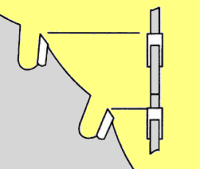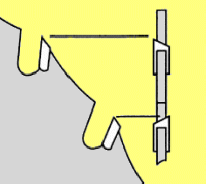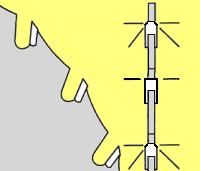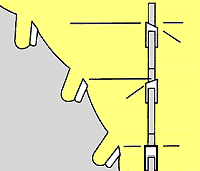TCT Saw Blades Tooth Configurations
Square Top Tooth
The top of each tooth is ground square, perpendicular to the sides of the blade. Square Top Grinds are designed for heavy duty cutting.

Advantages:
1. It cuts both sides of the kerf simultaneously, making it twice as effective as teeth in a staggered tooth saw in which each tooth cuts only one side at a time.
2. Its balanced cutting forces reduce saw body stresses.
3. It has large included angles between cutting edges that strengthen the tooth form and keep it sharp for longer periods of time.
4. The tooth form is relatively easy to maintain.
Disadvantages:
1. The tooth form generates relatively large cutting pressure and this contributes greatly to chip out or tear out at the exit point on the material.
2. Low side clearance angles inhibit the freedom of chip flow. The chips generated in the cut drag on the side of the cut causing a buildup.
Alternate Top Bevel (ATB)
The tops of alternating teeth are beveled to one side of the blade or the other at approximately 15 degrees. This tooth configuration bears a sharp pointed tip that provides a neat clipping action for very fine finishes. Two teeth will span the width of the kerf. Alternate Top Bevel Design shear cuts the material for clean cutting without chipping or splintering. For use on cutting wood, plywood, veneer, hardboard, fiberboard and particle board.

Advantages:
1. It produces very low cutting pressures that almost eliminate the tendency to tear out.
2. The chips fall free in the chip spaces created by the large side clearance angles.
Disadvantages:
1. The leading point is susceptible to wear and damage from shock loads.
2. Cutting forces perpendicular to the beveled edge result in semi-lateral thrusts on the saw body.
3. In sharpening it is difficult to maintain an equal bevel and equal diameter across the points of the teeth around the saw.
Triple Chip
The first tooth, or lead tooth, has a double 45 degree angle corner bevel. This is followed by a flat topped raker tooth ground lower the the lead tooth. The raker tooth removes the corners left on both sides by the beveled lead tooth. Triple Chip Grinds combines a balanced cutting force, low tooth drag and free chip flow. For use on cutting hardwood, plastics, and plastic laminated to wood.

Advantages:
1. Large included angles in the cutting edges give the triple chip form good wear resistance.
2. A balanced cutting force.
3. Low tooth drag.
4. Free chip flow.
Disadvantages:
1. The triple chip tooth form requires extra maintenance care to avoid the risk of changing tooth forms during sharpening. Alterations can lead to deteriorated cutting action.
2.This triple chip tooth form has strong blunt edges, there is a relatively low shear generating high cutting pressures which tend to produce chip outs.
Planer-Combination
Planer Combination combines 4 Alternate Top Bevel Teeth with 1 raker. The basic function of the raker tooth, which is lower than the tips of the scoring teeth and narrower: it removes the V-shaped piece of material left in the center of the cut by the alternating top bevel teeth. This tooth configuration provides a very smooth cut.

Advantages:
1. It produces very low cutting pressures that almost eliminate the tendency to tear out.
2. The chips fall free in the chip spaces created by the large side clearance angles.
3. A balanced cutting force.
Disadvantages:
1. The leading point is susceptible to wear and damage from shock loads.
2. In sharpening it is difficult to maintain an equal bevel diameter across the points of the teeth around the saw.